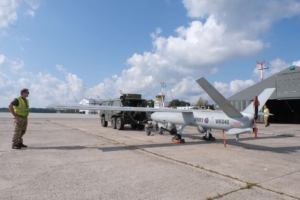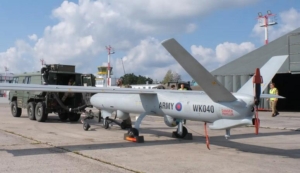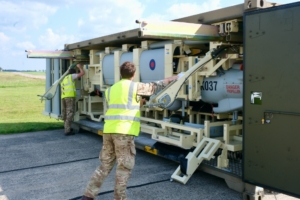The troubled Watchkeeper story draws to a close
November 29, 2024

On Wednesday 20 November, Secretary of State for Defence John Healey announced a package of Strategic Decommissioning measures in the House of Commons. These were aimed at taking “six outdated military capabilities” out of service by March 2025 in order to generate £500 million of savings that will be reinvested into defence. One of the six capabilities to be withdrawn was the Army’s fleet of 46 surviving Thales WK450 Watchkeeper UAVs.
Healey outlined the rationale for retiring the Watchkeeper system, explaining that: “A modern army must self-evidently have a modern drone capability able to operate in the most challenging environments. Following the retirement of Watchkeeper Mk 1, the Army will rapidly switch to a new advanced capability, drawing on the most recent operational lessons and technological developments.”

Responding to Labour MP Johanna Baxter, Healey noted that: “The best exemplification of the argument she makes is in the Army’s plans to rapidly replace the Watchkeeper Mk 1 capability. It is a 14-year-old drone in an era where, as Ukraine tells us, drone technology has a lifecycle of two to three months. The Army knows what it can do better. It knows it can do it more quickly. It knows how it will focus its efforts for the future. Decommissioning the Watchkeeper Mk 1s will allow it better to do that.
On 25 November, Minister of State Lord Coaker told the House of Lords that: “We are getting rid of Watchkeeper because that system has been in service since 2010 and, according to all the military chiefs, is out of date. The Ukraine war has shown that we need to replace it with something else,”
Watchkeeper was acquired as part of an ambitious effort to boost the British Army’s airborne intelligence, surveillance, target acquisition and reconnaissance (ISTAR) capabilities, replacing the BAE Systems Phoenix. Phoenix was used as a reconnaissance asset over Kosovo and Iraq in the 1990s but gained a reputation for unreliability -gaining the nickname ‘the bugger-off’ because it frequently never returned!
The Watchkeeper platform was a development of the Elbit Systems Hermes 450 tactical UAV. built by U-TacS, a joint venture company owned 50-50 by Elbit Systems and Thales UK at a facility near Leicester. Some 54 Watchkeepers were built under a £700 million combined development and production contract awarded to U-TacS in August 2005. These were intended to result in these “world-class” UAVs, operating in Afghanistan by mid-2010.
As an interim measure a number of Elbit Hermes 450s were procured under an urgent operational requirement known as Project Lydian, and these served in Afghanistan, operating from Camp Bastion from 2007.

The first flight of a Watchkeeper air vehicle took place in Israel in April 2008, and WK060 made the type’s first 20min UK sortie from the ParcAberporth centre in west Wales on 14 April 2010.

The Watchkeeper was operated by 47th Regiment Royal Artillery, performing the army’s ‘land tactical deep find’ role using an Elop CoMPASS electro-optical/infrared sensor and the Thales UK I-Master synthetic aperture radar and ground moving indication payload.
Programme delays meant that the system was not deployed to Afghanistan until September 2014. The three Watchkeepers deployed to Afghanistan for three weeks flew around 146 hours of surveillance supporting Afghanistan force protection efforts, as British forces withdrew from Camp Bastion.
The type has not been involved in major military operations since, though full operational capability was declared in November 2018, and a full release to service clearance was issued in April 2019.
Since then, Watchkeeper has deployed to Ascension Island, and the USA on exercise, and the type has also flown in support of the UK Border Force monitoring small boats attempting to bring illegal migrants across the English Channel from France. The Watchkeeper operated from Lydd airport in 2020, and 21 further flights were conducted in September and October 2022.
As well as being badly delayed, Watchkeeper proved to be unuseable in anything but VMC conditions, and eight were lost in accidents between 2014 and 2022, and there were a number of groundings of the fleet. The aircraft has a poor reputation, with one analyst describing it as: “a shambles of a platform. The sensor package great but the drone itself ruined the package.”
Mark Francois, a Conservative MP, former Conservative armed forces minister, and previously a prominent member of the House of Commons Defence Committee said that the project was “an unmitigated disaster, arriving years late and effectively already obsolescent.” He recently added that: “In theory, Watchkeeper is a highly capable system and an important asset for the future British Army. However, it was so over-specified in development that it is years late coming into service and also has an unfortunate tendency to crash; which, from a military viewpoint, is distinctly suboptimal!”
Watchkeeper’s shortcomings include the type’s relatively low operating altitude (about 15,000 ft), noisy powerplant and vulnerability to hostile fire, while it requires a sizeable logistics ‘tail’ to deploy and operate, and is viewed as being overcomplicated to operate.
The Watchkeeper mid-life extension (MLE) project passed initial approvals in August 2021, with initial operating capability scheduled for 2026 and full operating capability for 2027. This will now not happen, obviously, but the aircraft has received an ‘upgrade 2.3’ adding new radar modes.

Recent deployments included Exercise Desert Khanjar in Oman at the end of 2023, during which Watchkeeper designated targets for Apache attack helicopters. In October 2024, the army deployed Watchkeepers to Estonia to participate in the exercise Athena Shield, operating from Parnu airport.

In addition to U-TacS’ production for the British Army, a WK-X export version has been sold to Romania. Three systems were delivered to Romania after the June 2023 contract, which included technology transfer and local industrial participation.
By September 2022, it was announced that the UK had spent £1.31 billion on the programme, and then-Defence minister James Cartlidge confirmed in June 2023 that Watchkeeper had cost £1.35 Bn, including upgrades to airfields at Aberporth and Boscombe Down.

In the end, Watchkeeper fell victim to changing requirements. Watchkeeper was optimised for use in clear skies against enemies who couldn’t shoot it down, and many have contrasted the lack of GBAD capabilities in Afghanistan with the mass of anti-aircraft weapons seen in Ukraine, where the ongoing war has shown that large unarmed UAV may struggle to survive over the modern battlefield.
Battlefield reconnaissance is increasingly being done by small, cheap consumer grade FPV (first person view) drones rather than expensive aeroplane-sized UAVs, which may be too easy to interdict and shoot down, and too expensive to be truly attritable.
Labour MP Kevan Jones noted that: “Ukrainian forces have shown that many of Watchkeeper’s capabilities can be delivered for a fraction of the cost.”
Colonel Hamish de Bretton-Gordon, a retired British Army officer observed that: “Ukraine’s artillery is so effective these days because virtually every Ukrainian artillery shell that’s fired has a drone on the other end marking its strike.” Many are now questioning how the British Army will find targets for the artillery, following the retirement of the Bombardier Sentinel R.Mk 1 which led to a loss of wide area GMTI and now the withdrawal of Watchkeeper.
Respected analyst Gabriele Molinelli acidly commented that: “Ground Moving Target Indication radar tracking of surface targets is clearly considered a decadent capitalist luxury.”
He seems to have a point!
















